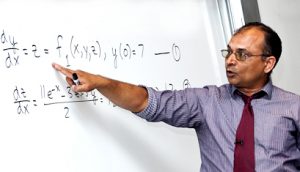| 11 Topics |
1 million visits per year |
1.6 million YouTube views per year |
Top 10 in Search Engines for numerical methods |
About the Course
Numerical methods are techniques to approximate mathematical procedures (e.g., integrals). Approximations are needed because we either cannot solve the procedure analytically (e.g., the standard normal cumulative distribution function) or because the analytical method is intractable (e.g., solving a set of a thousand simultaneous linear equations for a thousand unknowns). By end of this course, participants will be able to apply the numerical methods for the following mathematical procedures and topics: differentiation, nonlinear equations, and simultaneous linear equations, interpolation, regression, integration, and ordinary differential equations. Additionally, they will be able to calculate errors and implement their relationship to the accuracy of the numerical solutions. To be prepared for this course, students should have a passing grade in introductory physics, integral calculus, differential calculus, and ordinary differential equations.
Course Materials
Simply click on topics to access the courseware which includes the following: textbook content, lecture videos, PowerPoint presentations, multiple-choice questions, blog, simulations, related physical problems to engineering majors, and worksheets. We have social media presence through a blog, a YouTube channel, Instagram, Twitter, and a Facebook page. We also have a MOOC that you can access to take the course in an organized manner.
History of This Open Education Resource (OER)
After successfully extending an interactive educational software package on an Apple IIe in 1985 and developing it from scratch for MS-DOS in 1989 with an Independent Study student for a course in Mechanics of Composite Materials, the idea of this open courseware in Numerical Methods was first formed in 1990. Suffering through three failed attempts (1990, 1991, 2000) of soliciting funding from several foundations, the concept was shelved till 2001.
Development restarted in 2001 w hen MIT OCW was released and the open courseware concept gained immediate acceptance. It took three consecutive grants from NSF (2002-2012) and a village of colleagues and students around the nation to develop the courseware. Read or hear the history behind the courseware.
hen MIT OCW was released and the open courseware concept gained immediate acceptance. It took three consecutive grants from NSF (2002-2012) and a village of colleagues and students around the nation to develop the courseware. Read or hear the history behind the courseware.
The development of the courseware is ongoing but was completed mostly by 2012. Since then, the courseware has been used to conduct educational research on the cognitive and affective efficacy of flipped classrooms, and the use of adaptive learning in such settings.
Course Structure
This University of South Florida course is taught on campus twice per week for 75 minutes. The printed textbook for the course is available for purchase online. while the individual textbook chapters (fewer problem sets) can be accessed online.
Topics
Introduction
Differentiation
Nonlinear Equations
Simultaneous Linear Equations
Intro to Matrix Algebra
Gaussian Elimination
Interpolation
Regression
Integration
Ordinary Differential Equations
Optimization
Partial Differential Equations
Introduction to Partial Differential Equations
Parabolic Partial Differential Equations
Elliptic Partial Differential Equations
Fast Fourier Transforms
